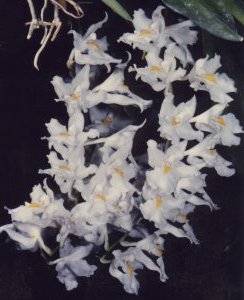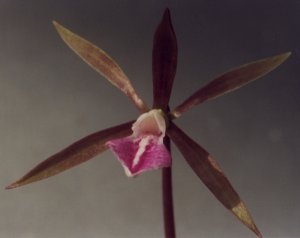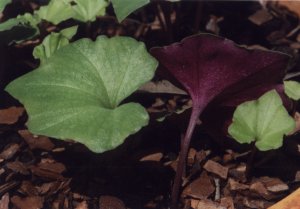|
|
|
CONTACT US
Click Here! |
| This site is best viewed with a screen resolution of 800 X 600 at high colour settings |
|
Flask list
Acacallis-Ancistrochilus Angraecum-Aspasia Barkeria-Broughtonia Bulbophyllum Capanemia-Catasetum Cattleya Cattleyopsis-Cycnoch, Cymbidium-Cyrtorchis Dendrobium-Dossinia Encyclia-Eulophiella Galeandra-Kalopternix Laelia-Lycaste Macodes-Nephalaphyll, Odontogloss,-Oncidium Paphiopedilum-Psychilis Rangaeris-Stenocoryne Tainia-Zygopetalum |
|
Plant list
Acampe-Bulbophyllum Cattleya-Dossinia Encyclia-Promeaea Renanthera-Vanda |

BP SPECIES NEWSLETTER October 2001Jan01 Feb Mar April May June July August September
Photos in this issue: Above Eulophia species Ceylon. Rodriguezia venusta, Nervilia uniflora, Phalaenopsis gibbosa.Do you know any orchid growers who may like to receive this newsletter? Why not forward this email to them now!A b&w printed copy of this Newsletter can be mailed each month if you send 12 Australian stamps or 12 International reply coupons to Burleigh Park Orchid Nursery, 54 Hammond Way, Thuringowa, Australia 4815.Items in this newsletter may be reproduced provided source acknowledged.We commend "Orchids Online Web Design" for the excellent work on our web site and this Newsletter.For information or prices click here or email Steve at steve@orchidsonline.com........A. What's New in flask.Eulophia species Ceylon. This is so far unidentified, any suggestions would be welcome (photo above). A subterrainium tuber, with a single or paired narrow, plicate leaf to 30cm long ( 12 inches), this requires a rich soil leafmould media in a well drained pot. Decidous in winter, a repot each spring is of benefit. Maximum sunlight, short of leaf burn, and a warm spot in the orchid house.Bulbophyllum patens. A robust growing species that needs a shallow tray or a piece of treefern to wrap around. A media that will hold some moisture or well watered treefern and maximum sunlight is needed. The flowers are a waxy ruby red, with some fine red spotting, borne on short upright pedicels along the rhizome in quantity. B. What's ready to replate NOW.Paphiopedilum primulinum. A sib cross between two very nicely coloured yellow, tinged green clones.Stanhopea costaricense, a warm growing 'upside down orchid' that when mature, will need a basket so that its flower spike can go thru the basket and the flowers hang beneath. Large flowers to 12.5cm ( 5 inch), pale cream yellow with pale redbrown spots and blotches, very fragrant, and quite spectacular. Small plants are best grown in a well drained spaghnam moss or similar mix, as they appreciate being damp but not soggy wet. Phalaenopsis gibbosa is a rare species, similar in growth to P. parishii and P. lobbii. It seems to do best on a slab, treefern if available or a piece of cork bark with extra water. In the cooler months, water should be withheld short of dehydrating the plants. It is reputed to be a warm growing jungle plant that grows in heavy shade. C. What's new in Plants.Specimen plants Dendrochilum cobbianum and Dendrochilum magnum.These are multigrowth plants, grown in a mixture of spaghnam moss and isolite. Both species do well in an intermediate to warm climate, with plenty of sunlight. The flowers are borne on long spikes that go up then hang down, with masses of fragrant flowers. D cobbianum is pale green white, and D magnum is orange. 
Currently, flowering size plants are growing well in 80mm basket pots in a mix of spaghnam moss and isolite, with similar light conditions to that required by Dendrobiums. Paphiopedilum primulinum, a clear yellow, tinged with green lady slipper orchid. These do well in a media that drains well but retains some moisture, and where they get good light. Currently in 10cm pots in a mix of composted bark and isolite. 
A small tuber puts up an attractive heart shaped leaf, green, purple underneath, best grown in a small pot in a leafmould rich soil media. While growing maximise water and grow in a good shady spot as it is a dweller of the edges of rainforest in heavy shade.  Photo: Nervilia uniflora
Photo: Nervilia uniflora
Flower above Plant right D. Culture
The monopodial orchids are those that have a continuous growing stem, from very
short as in Phalaenopsis , to very long as in terete Vandas.
Aerides, Ascocentrum, Renanthera,Vanda and the like, are mostly orchids from the
tropics, where they receive high humidity and rainfall. They use their roots to both nourish
and attach themselves to trees , rock faces or just suspend themselves from the branches.
|
|
Suppliers of Fine Orchid Literature
|
Grahame & Margaret Muller
Fax: 07 4122 4539 International Fax: + 61 7 4122 4539
P O Box 4192 Tinana, Qld, AUSTRALIA 4650.
Email:gmuller@mary.big.net.au
ORCHIDACEOUS BOOKS is an Australian specialist supplier of orchid literature.
We stock more than 100 new titles with more available at short notice.
We buy and sell pre-owned titles and generally stock in excess of 150 pre-owned titles.
If you are searching for a particular title - New or Pre-owned - email us now for our current catalogue as we may have it in stock or may be able to source it for you.
All stock available for world wide delivery
H. A special note on flasking orchids.
Due to the need for a filtered air vent on flasks to allow exchange of gasses, a reliable air filter medium is needed.Non absorbant cotton wool allows gas exchange but does not absorb moisture. Thus the air filter will stay dry and prevent the growth of fungus thru the filter, a common problem with ordinary cotton wool which gets wet, goes mouldy and allows the mould to grow thru the filter to contaminate the flask.
Non Absorbant Cottonwool NOW AVAILABLE in 375 gram rolls, contact us NOW.
